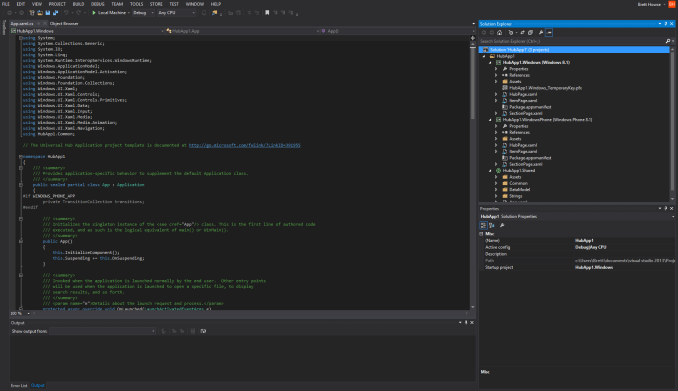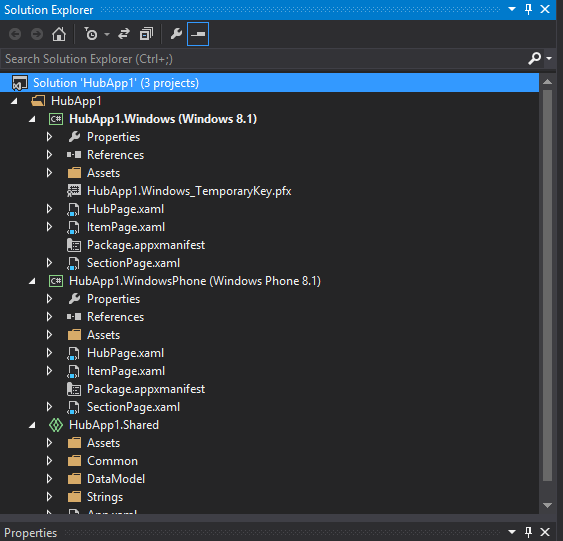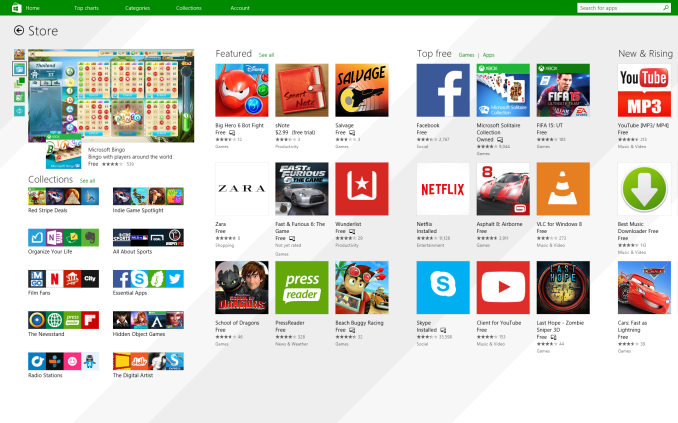Windows 10 Technical Preview First Impressions: The Return Of The Desktop
by Brett Howse on November 13, 2014 8:00 AM EST- Posted in
- Software
- Microsoft
- Windows 10
Universal Apps and the Windows Store
We just got done discussing why a single user interface for the OS across multiple devices is not always the ideal solution, so of course the obvious question with Universal Apps is why would you want it with the app model instead? Thankfully this is not the case although the term Universal App might lead people to believe they are attempting to have a single app target all of their platforms. The truth of the matter is that Universal Apps are Universal in the sense that they share a common app store.
If Microsoft is going to have Windows 10 succeed on desktops, laptops, tablets, phones, and even Xbox One, they need developer buy-in. A platform without apps is not much use to anyone. With the Universal App, they can bridge all of their platforms with a single App in the store. Under the hood, each app is created with a common framework of code, as well as multiple user interfaces in order to tailor the experience to the correct device type. Below is a screenshot of Visual Studio – Microsoft’s developer tools – with a new Universal App about to be created.
 Visual Studio Showing a Universal App Project
Visual Studio Showing a Universal App Project
As you can see, there is a shared portion of code, and then a project for the UI for Windows 8.1, and Windows Phone 8.1. Xbox One is not available yet, but should be added in a future release of Visual Studio.
A close up of the projects
But you may be wondering why any of this is necessary. Windows has the largest selection of applications of any system ever. That is of course true, and the Win32 framework has served both Windows and its users well over the years. But with the new WinRT framework there are some big advantages. First, it can be written to in multiple languages including HTML. WinRT supports C++/CX, C#, VB.NET, and HTML scripting with JavaScript and TypeScript. The security model for WinRT apps is a lot different than Win32, with all WinRT apps running in a sandbox mode for higher security. Unlike apps written in .NET, WinRT is native code, which should result in better performance. Contracts and Extensions are also new to WinRT, and allow apps to share data while still being in a sandbox. One of the biggest advantages of WinRT is that it is DPI aware, and can automatically scale apps appropriately based on screen size and screen resolution. Here, as we know, Win32 apps can struggle even though there are solutions in place.
Adobe Touch WinRT (left) vs Adobe Reader Win32 (right) on HiDPI display
One of the biggest disadvantages of WinRT is that it is only available on Windows 8 and newer devices. With Windows 8 struggling in the market as compared to Windows 7, the user reach of a developer targeting WinRT apps in the Windows Store would be for a subset of the total user base. With Windows 7 having over 50% of the desktop OS market share to itself, this is going to be an issue.
With Windows 10, Microsoft is certainly targeting Windows 7 users. If they can convince them to upgrade to the latest version of the operating system, then the new environment will have a much larger target base and will hopefully encourage developers to target the Windows Store. We have not heard of any upgrade promotions or pricing yet, but this is one of the biggest advantages Apple has had over the years. Their user base generally upgrades the OS at a much faster uptake than Windows. This allows developers to utilize newer APIs in the latest versions of their operating systems and keep the platform progressing. Microsoft has already had to deal with people being stuck on Windows XP, and they must be wanting to avoid that with Windows 7.
Since we are discussing Universal Apps and their advantages, one of the biggest advantages is the Windows Store. With Microsoft hosting the entire download and purchase of all WinRT apps, having user settings and apps sync from one device to another is much easier. One of the greatest experiences with Windows 8.1 is signing into a new PC for the first time. When you log in with your Microsoft Account, the system asks you if you would like to copy the devices and apps from one of your other devices, or if you want to start with a clean machine. If you choose a previous machine, all of the settings, wallpaper, Start Screen layout, and Windows Store apps are synced to the new device. In the case of Windows Store apps, the app itself is listed on your Start Screen, but it is not downloaded until the first time you select it. This avoids a situation where you will significantly delay the initial login time with a massive download, as well as avoid filling the available storage with apps you may not need on that particular device.
Also, like modern tablet and smartphone OSes, WinRT apps from the store are automatically kept up to date by the store. This avoids a lot of the issues with viruses and malware attacking an older version of a product since in theory it will not be around any longer.
The one thing missing from this are the older Win32 apps on the desktop, because they are not available in the Windows Store. Prior to Windows 10, desktop apps could be listed in the store, but the store would then link to the developer’s website to allow you to purchase and install the app. With Windows 10, rumors are that desktop apps will also be available and managed through the Windows Store. Assuming this does happen, then this will be a major boon to users. Desktop apps should in theory also be able to be kept up to date using the Windows Store which should cut back on the number of outdated pieces of software targeted by malware.
The Windows Store is a key piece of Windows 10. Universal Apps can be made available for multiple platforms through the store, and, if the rumors are true, even desktop apps will be available through the store. This should make the Out Of Box Experience (OOBE) very good for users with a Microsoft Account. The WinRT framework has not yet had the killer app written for it, so hopefully with Windows 10 the framework will be expanded to allow for more powerful apps to be created.













198 Comments
View All Comments
valnar - Monday, November 17, 2014 - link
I don't quite understand the Metro app thing on a desktop. It's a regression in every way. Single app, full screen, doesn't run in the background, etc. Yes, I know Apple does this with iOS but it works for a small device, small screen, and limited memory. On a desktop computer, running an app the way Microsoft designed Metro harkens it back to DOS days. It's called Windows, not Window. Glad they are finally fixing some of that in Windows 10.TinHat - Monday, November 17, 2014 - link
+1Ubercake - Monday, November 17, 2014 - link
Seems like Windows 10 is turning out to be everything Windows 8 was meant to be (ie Unified desktop) while incorporating customer feedback. Looks pretty good.Kutark - Monday, November 17, 2014 - link
Really wish they would at least give the option of enabling aero again. I know in the end its a relatively minor quibble, but i can't express in words how much i hate the stupid pastel themed title bars/windows, etc.Kutark - Monday, November 17, 2014 - link
I should also mention, while win10 looks like a nice step in the right direction, i still think they're going to get the shaft with gamers when steamos comes out (depending on developer support of course). I can honestly say that i've not once, literally not once, had a need or ever clicked, used, or looked at the stupid touch interface (whatever they call it) in months of using windows 8.1. I just need a desktop where i can put icons, a web browser, etc. I don't need "apps" ala a smartphone. If i do, i'll use my smartphone/tablet. Desktops are primarily for "serious business" and all this crap does is get in the way of your ability to efficiently use the system.That being said all the backend stuff in windows 8.1 is great. I will say it works well.
Che - Tuesday, November 18, 2014 - link
I am so in agreement with the above. It is killing me to give up aero. Everytime I see these pics of windows 10, or use windows 8/8.1 it just visually hurts.jrs77 - Tuesday, November 18, 2014 - link
I don't want something fancy for touch-screens and all these widgets, apps, etc.I'm using Windows only on my workstation and for that I need an OS that works with keyboard and mouse first and foremost.
Microsoft should'nt try to integrate all the devices but simply have one OS for mobile devices and one for dektop workstations.
R. Hunt - Tuesday, November 18, 2014 - link
This is still FrankensteinOS, and "Modern" apps look and feel like they were running on a mobile emulator rather than actual desktop applications. Sorry, not impressed, not really seeing how this is any different from Windows 8 or what the hype is all about. All I see is Microsoft still desperately trying to push Metro, their App Store, and associated services on desktop users.Techstedt - Tuesday, November 18, 2014 - link
"a lot"JackMenendez - Wednesday, November 19, 2014 - link
I don't know why it is so hard to understand Windows 8.x failure. There are different kinds of input for navigation and feedback to that input. The design of the UI should be optimum for the kind of input used. If you have a touch screen then a touch screen UI is probably what you are looking for; Windows 8.1 great. If you don't have a touch screen, then a mouse and/or keyboard input UI is what you are looking for; Windows 7 great. When Microsoft put a touch screen UI on a system with only mouse and keyboard input then it is not optimum; it is not what people want. Microsoft went one step further, they took away a UI optimized for mouse and keyboard and replaced it with a UI optimized for touch when most computers don't have touch. This move is called shooting the foot off.Someday, we will have a computer that understands speech so well that we won't need a navigation input. Kind of like the fictional computers on Star Trek. Will we put a touch UI on these? Will it be
"Computer, touch the start button then touch the sensors button, then touch the scan enemy ship button"
Or will it be
"Computer, Scan the enemy ship"?
One kind of UI for all things represents complete ignorance of how people use computers. Stack Exchange lists VIM as one of the most popular IDE's for writing code; for C++ VIM is as popular as Visual Studio. VIM, think about it. For some things touch and mouse are not as good as something developed in the early 1970's but Microsoft does not seem to get that.